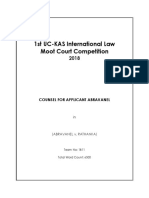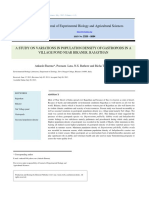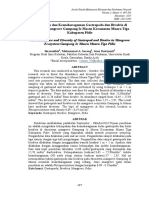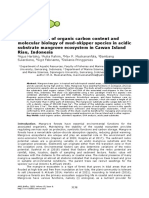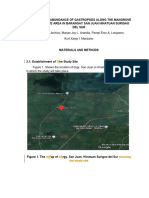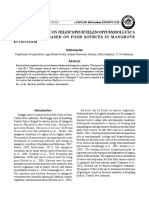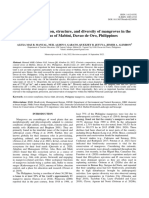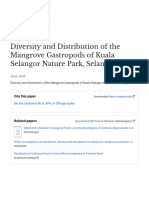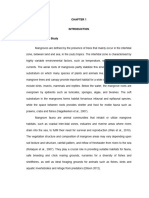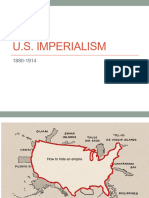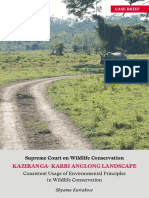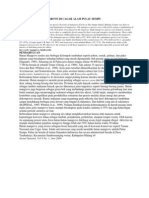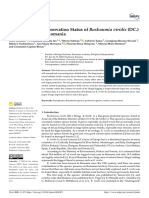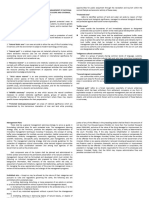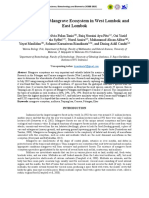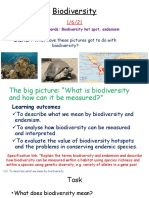Gastropod Community Structure in Mangrove Pancer Cengkrong Ecosystem, Trenggalek Regency, East Java
Gastropod Community Structure in Mangrove Pancer Cengkrong Ecosystem, Trenggalek Regency, East Java
Volume 9, Issue 11, November – 2024 International Journal of Innovative Science and Research Technology
ISSN No:-2456-2165
Gastropod Community Structure in Mangrove
Pancer Cengkrong Ecosystem, Trenggalek
Regency, East Java
1
Diana Arfiati; 2Feni Iranawati; 3Titis Dwi Andhani; 4Kharisma Orchida; 5Kenny Fajar Aprilian;
6
Zakiyyah Nur Inayah; 7Rizky Kusma Pratiwi
1,2,3,4,5
Brawijaya University, Malang, 65145, Indonesia
Abstract:- The condition of mangrove vegetation habitat conversion of mangrove land into aquaculture ponds and
determines the community structure of organisms plantation land by the community. Damage to mangrove
associated with it, including gastropods. Mangrove ecosystems, has an impact on the disconnection of mangrove
Pancer Cengkrong is located in Trenggalek Regency, ecosystems with other ecosystems [1]. This causes a decrease
which is a conservation and ecotourism area. The purpose in the ability of mangroves, in supporting the lives of biota
of this study is the identification of gastropods that inhabit it, one of which is gastropods [3]. Gastropods in
morphologically and the abundance of gastropod species. mangrove ecosystems, act as environmental bioindicators, so
The research was conducted in August 2024, using the their existence is very important for the ecosystem [4].
survey method, at 6 research points using transects, the Pressure caused by human activities can change habitat
size transect is 10 x 10 m. Mangrove species found as conditions and disrupt the survival of gastropods [5]. A
many as 9 species, with mangrove density ranging from decrease in gastropod density may indicate compromised
0.038 - 0.078 ind/m2. Gastropods found as many as 10 ecosystem health [6]. Therefore, research on the
genus, consisting of Cerithidea genus, Littoraria, Faunus, identification and density of gastropods in mangrove
Tarebia, Clypeomorus, Crassispira, Nerita, Terebralia, ecosystems is very important to determine the environmental
Neritina, and Cassidula. The abundance of gastropod conditions in the Mangrove Pancer Cengkrong area. The
species ranged from 34.4 - 92.4 ind/m2, with the highest results of this study are expected to be a reference in the
abundance in the Cerithidea genus and the lowest in the management and protection of mangrove ecosystem
Nerita and Neritina genus. The diversity index ranged resources and the biota that inhabit it.
from 0.84 to 1.30 (low-medium), the uniformity index
ranged from 0.36 to 0.57 (low-medium), and the II. METHOD
dominance index ranged from 0.37 to 0.60 (some points
had genus dominance). Water temperature (27.2 - 28.8℃), The research was conducted at Mangrove Pancer
pH (7.2 - 7.8), DO (4.48 - 5.31 mg/L), and salinity (24 - 29 Cengkrong (MPC), Karanggandu Village, Watulimo District,
ppt), water quality parameters are considered good for Trenggalek Regency, East Java Province. The research was
gastropod life. The structure of the gastropod community conducted in August 2024, method is a survey method with
in the MPC ecosystem is classified as slightly unstable, purposive sampling. The research location is in the form of
because there are still several points that have low transects totaling 6 points, where the transect size is 10 x 10
diversity and uniformity values, and there are points that m, with 5 plots measuring 1 x 1 m. The description of each
have a dominance value close to the value of 1, which sampling point is as follows:
means there are several genus that dominate. Continuous
monitoring and management of mangrove ecosystems are Point 1, at coordinates -8.302897° N and 111.74674° E,
needed so that the gastopod community remains in a natural mangrove area
balanced condition and there is a need for efforts to utilize Point 2, at coordinates -8.296539° N and 111.70637° E,
Cerithidea gastropods. rehabilitated mangrove area.
Point 3, at coordinates -8.296847° N and 111.706453° E,
Keyword:- Gastropods, Habitat, Mangrove, Community near the entrance to the ecotourism area.
Structure, Trenggalek Point 4, at coordinates -8.284983° N and 111.71693° E,
river estuary area.
I. INTRODUCTION Point 5, at coordinates -8.303292° N and 111.70499° E.
Point 6, at coordinates -8.302771° LS and 111.706331° E,
Mangrove ecosystems in Indonesia are evenly inland mangrove zone.
distributed, and have many ecosystem services. Trenggalek
Regency has a mangrove ecosystem area, namely Mangrove
Pancer Cengkrong (MPC), which is included in the
conservation and ecotourism area. It was recorded that
mangrove damage in this area reached 50% in 2003 [2].
Factors that are thought to affect this damage is the
IJISRT24NOV1195 www.ijisrt.com 2815
Volume 9, Issue 11, November – 2024 International Journal of Innovative Science and Research Technology
ISSN No:-2456-2165
Illustrates the Establishment of Sampling Transects: Gastropod Diversity Index
The following is the formula for determining Index [8]:
𝐻 ′ = − ∑ 𝑝𝑖 ln 𝑝𝑖 …(3)
Description:
H’ = Species Diversity Index
Pi = Probability for each species (ni/N)
Classification of Species Diversity:
Nilai H’ > 3 = high diversity
Nilai H’ 1 ≤ H’ ≤ 3 = medium species diversity
Description: Nilai H’ < 1 = low diversity
Gastropod Species Abundance Index:
= Research Transect
= Gastropod Collection Plot Abundance value calculation formula:
Number of individuals of the species
K= 2 …(4)
Sample plot area (m )
Referring to the mangrove species guidebook. If there is Number of individuals of the species
any doubt during the identification process, plant parts such KR = 𝑛𝑢𝑚𝑏𝑒𝑟 𝑜𝑓 𝑖𝑛𝑑𝑖𝑣𝑖𝑑𝑢𝑎𝑙𝑠 𝑜𝑓 𝑎𝑙𝑙 𝑠𝑝𝑒𝑐𝑖𝑒𝑠
… (5)
as leaves, flowers and fruits can be collected for further
analysis. Gastropod Diversity Index (E)
The uniformity index (E) was calculated using the
Gastropod sampling was carried out by digging the soil Shannon Evennes Index formula :
to a depth of ± 10. Next, a screening process was carried out
using a multilevel sieve with sizes 4.75 mm, 2.00 mm, 1.00 𝐻′
E = ln S … (6)
mm, 100 µm. Samples were put into a container, then given
50% alcohol as a preservative. Counting and identification of
gastropod species were carried out at the Hydrobiology Description:
Laboratory, Faculty of Fisheries and Marine Science,
Universitas Brawijaya. Sample identification used the book E = Uniformity index
Tropical Seashells (1998) and Morris (1963). H’ = Diversity index
S = Number of organism species
Water quality measurements include temperature and
dissolved oxygen using a DO Meter, pH using a pH meter, Classification of the Species Uniformity Index:
and salinity using a Refractometer. Determination of
substrate type is done with Sieve Analysis. E > 0,6 = High species uniformity
0,6 ≥ E ≥ 0,4 = Medium species uniformity
Data Analysis E < 0,4 = Low species uniformity
Data on mangrove vegetation structure, water quality
and gastropod species composition were tabulated in tables Dominance Index
and graphs and then analyzed descriptively. The calculation of the domiannce index (D) is calculated
using the Simpson Dominance Index formula as follows:
Mangrove Density
𝑛𝑖
Mangrove density calculation formula [7], as follows: 𝐷 = ∑( 𝑛 )2 … (7)
N
Di = Ai … (1) Description:
𝑁
𝑅𝐷𝑖 = ∑ 𝑖 𝑥 100% … (2) D = Dominance index
𝑛 ni = Number of individuals of each species
n = Total number of individuals
Description:
Classification of Community Conditions:
Di = Density
Ni = Number of individuals of species i 0<C≤0,5 = No dominance
A = Total area of sampling area 0,5<C<1 = There is dominance
Rdi = Relative density (%)
Ni = Number of individuals of the lth species (ind)
∑n = Total number of individuals (ind)
IJISRT24NOV1195 www.ijisrt.com 2816
Volume 9, Issue 11, November – 2024 International Journal of Innovative Science and Research Technology
ISSN No:-2456-2165
Gastropod Distribution Pattern as major mangroves and natural mangroves, so the mangrove
Gastropod Distribution patterns were calculated using species are more heterogeneous.
the Morisita Index [9]:
Table 1: Mangrove Species Density
∑ 𝑋 2 − ∑ 𝑋𝑖 Point Mangrove Density
𝐼𝐷 = 𝑛 ((∑ 𝑋𝑖)2−∑ 𝑋𝑖) … (8)
1 0.063
2 0.060
Description: 3 0.050
4 0.078
ID = Morisity Dispersion Index
5 0.042
n = Total number of quadrants
6 0.038
∑Xi = Total number of gastropod species
∑Xi2 = Number of i-th gastropod species
Variations in mangrove density can be influenced by
environmental conditions at the study site. In the mangrove
Furthermore, the calculation of chi square (x2) with n-1
rehabilitation zone, mangrove species tend to be more
free degrees, for the significance of Morisita Index
homogeneous. This condition is similar to Point 3, where
calculation, namely:
mangrove stands are dominated by seedlings and saplings,
Uniformity Index:
with the species Rhizophora apiculata. The Rhizophora genus
𝑋 2 0.975−𝑛+ ∑Xi thrives in areas influenced by tides. The pattern of adaptation
𝑀𝑢 = (∑Xi)−1
… (9) to the environment is very good, so that the seeds are easily
spread, grow, and develop in the region [10].
Mu = Moricity Index for uniform distribution pattern
Mc = Moricity Index for clustered distribution pattern C. Gastropod Community Index
X20.975 = The chi square value for n-1 free degrees Gastropod observations in Mangrove Pancer Cengkrong
X20.025 = The chi square value for n-1 free degrees (MPC), there are 10 genus identified, namely the genus
Xi = Number of individuals in the plot Cerithidea, Littoraria, Faunus, Tarebia, Clypeomorus,
n = total number of sampling plots Crassispira, Nerita, Terebralia, Neritina and Cassidula.
Gastropods were highest at Point 1, with a total of 462
Determination of Gastropod Dispersal Patterns: individuals and lowest at Point 3, with a total of 172
individuals. The Cerithidea genus was found the highest with
Id > 1 = clustered a total of 1314 individuals, while the lowest was the
Id < 1 = same nature Terebralia genus with 2 individuals. The difference in the
Id = 1 = random number of individuals found can be influenced by
environmental conditions, adaptation patterns, food sources,
III. RESULT AND DISCUSSION and individual distribution patterns [11]. Differences in
density and composition of gastropod species cause the
A. Mangrove Vegetation Structure formation of gastropod zonation. The differences that occur
Mangrove species found totaled 199 individuals, can be caused by differences in sampling distance and
including Avicennia alba, Bruguiera gymnorrhiza, environmental factors.
Rhizophora apiculata, Rhizophora mucronata, Sonneratia
alba, Sonneratia caseolaris, Aegiceras floridum, Ceriops D. Gastropod Abundance Index
tagal, and Avicennia marina. The highest amount of The results of the gastropod abundance index in the
vegetation was found at Point 4 with a total of 47 individuals, MPC, ranged from 34.4 - 92.4 ind/m2. The highest abundance
while the lowest was at Point 6 with 23 individuals. value was found in the Cerithidea genus at Point 1 at 67.6
Rhizophora apiculata species were found most at Point 3, and ind/m2 and the lowest was the Nerita genus at Point 3,
Aegiceras floridum was found least at Point 2. The large Terebralia genus at Point 2, Neritina genus at Points 3 and 4,
number of Rhizophora apiculata species found, can be with an abundance of 0.2 ind/m2 (Fig 1). The highest
influenced by mangrove rehabilitation activities carried out in abundance was found in the Cerithidea genus, where this
dominated by this species, so the number is more than other genus was spread across all observation points. The high
species. abundance of the Cerithidea genus, because this genus
belongs to the Potamididae family, which is a native family
B. Mangrove Density of mangrove forest dwellers.
The highest mangrove species density was found at
Point 4 at 0.078 ind/m2, followed by Point 1 at 0.63 ind/m2,
and the lowest at Point 6 at 0.038 ind/m2 (Table 1). The
highest species density by Rhizophora apiculata species and
the lowest by Bruguiera gymnorrhiza species. Mangrove
species at point 4 (near the estuary) and point 1, are classified
IJISRT24NOV1195 www.ijisrt.com 2817
Volume 9, Issue 11, November – 2024 International Journal of Innovative Science and Research Technology
ISSN No:-2456-2165
Fig 1: Gastropod Abundance Index
The high abundance of gastropods at Point 1 is E. Gastropod Diversity Index
positively correlated with the high mangrove density at Point The results of the diversity index (H') of gastropods,
1. This is because high mangrove density will affect the ranged from 0.84 - 1.30. The highest diversity index value
availability of food sources [12]. The low abundance of the was at Point 3 with a value of 1.30 (medium category). The
genus Nerita and Neritina, may be influenced by the factor lowest diversity index value was at Point 4 and 5 with a value
that this genus is a visitor gastropod group in mangrove of 0.84 (Fig 2).
ecosystems [13].
Fig 2: Gastropod Diversity Index
The high diversity index value at Point 3 can be species dominate, then the community is said to have low
influenced by the number of species and species distribution. species diversity [15].
Low species similarity and few species population values are
some of the factors that can affect the low value of the F. Gastropod Uniformity Index
diversity index in an ecosystem [14]. A community can be The value of Diversity Index (E) of gastropods in
said to have high species diversity if it is composed of many Mangrove Pancer Cengkrong ranges from 0.36 - 0.57. The
species with the same or almost the same abundance. highest uniformity index value is found at Point 3 with a value
Conversely, if it is composed of a few species and only a few of 0.57 (medium category). The lowest uniformity index
value is found at Point 4 and 5 with a value of 0.36 (Fig 3).
IJISRT24NOV1195 www.ijisrt.com 2818
Volume 9, Issue 11, November – 2024 International Journal of Innovative Science and Research Technology
ISSN No:-2456-2165
Fig 3: Gastropod Uniformity Index
The low uniformity index of gastropods, in the range of makes one species more dominant. High uniformity reflects
0.00<E<0.50, reflects that the community is under stress. The an ecosystem that supports a variety of species in a balanced
highest uniformity index value is found at Point 3 with a value manner [17].
of 0.57. Although it has the highest value of all observation
points, the uniformity index at Point 3 is classified as G. Gastropod Dominance Index
moderate. The lowest uniformity index values were found at The Dominance Index (C) value of gastropods in
Points 4 and 5 with a value of 0.36. A uniformity index that Mangrove Pancer Cengkrong ranged from 0.37 - 0.60 (Fig 4).
reaches 1.00, indicates that the organisms in the ecosystem The highest gastropod dominance index was found at Point 2
have the same number and type of organism [16]. This at 0.60 (there is species dominance), while the lowest was at
condition is caused by an environmental imbalance that Point 3 at 0.37 (no species dominance).
Fig 4: Gastropod Dominance Index
The highest gastropod dominance index was found at followed by a high uniformity index. This correlates with the
Point 2 at 0.60, while the lowest was at Point 3 at 0.37. The uniformity index value found at point 3. In accordance with
dominance index category at point 2 is included in the the statement that the high and low dominance index values
category of dominant species. The lowest dominance index are interrelated with the uniformity index value. A low
value is found at point 3, with a value of 0.37. This value dominance index value states that there is no dominating
indicates that at point 3, the dominance index value is species [19].
included in the category of no species dominance [18].
Generally, a low dominance index value will always be
IJISRT24NOV1195 www.ijisrt.com 2819
Volume 9, Issue 11, November – 2024 International Journal of Innovative Science and Research Technology
ISSN No:-2456-2165
H. Gastropod Distribution Patterns group. There is 1 genus with random distribution and 9 genus
The distribution pattern of gastropods found in the with group distribution pattern (Table 2).
Pancer Cengkrong Mangrove ecosystem is random and
Table 2: Gastropod Distribution Pattern
No Genus Ip Distribution Pattern
1. Cerithidea 0 Random
2. Littoraria 1 Group
3. Faunus 1 Group
4. Tarebia 1 Group
5. Clypeomorus 1 Group
6. Crassispira 1 Group
7. Nerita 1 Group
8. Terebralia 1 Group
9. Neritina 1 Group
10. Cassidula 1 Group
The Cerithidea genus with a random distribution Salinity values ranged from 24 - 29 ppt. The highest
pattern, it can be said that this genus has a high adaptability salinity was found at Point 4, which was 29 ppt, and relatively
to various environmental conditions. In this study, the genus the same at Points 1, 2, and 3, which were 24 ppt. The high
found clustered, tending to be found only at certain points. salinity at Point 4 was influenced by the measurement
The existence of a clustered distribution pattern is a natural location at the mouth of the river, so the salinity value was
thing that occurs in nature, where there is a collection of higher than other points. The quality standard of salinity for
individuals at a certain point. This can occur because the form gastropod life ranges from 25-40 ppt [24].
of adaptation in each genus is different to environmental
changes [20]. IV. CONCLUSION
I. Substrate Type The structure of the gastropod community in the Pancer
Substrate type affects gastropods in mangrove Cengkrong Mangrove ecosystem includes 10 genera with
ecosystems [21]. In this study, the substrate type at points 1, species abundance ranging from 0.2 - 67.6 ind/m². Diversity
2, and 3, had a sandy clay loam substrate texture, while at and uniformity indices were at low - medium levels, while the
points 4, 5, and 6, had a sandy loam substrate texture. The dominance index showed the dominance of the Cerithidea
sandy clay loam substrate type, showed the highest genus at Point 3. Water quality parameters, such as
abundance of gastropod species and higher mangrove density temperature, pH, DO, and salinity, support the life of
compared to other points. Substrates dominated by sand gastropods in this ecosystem. Continuous monitoring and
tended to have lower gastropod species, except at point 4 ecosystem management are needed to maintain the stability
which is located in the estuary area. of the gastropod community in a sustainable manner.
J. Water Quality REFERENCES
The results of the measurement of water temperature
parameters, ranging from 27.2 - 28.8 ℃. The highest [1]. S. F. Hamzah, H. Hamdani, S. Astuty, and M. R.
temperature was found at Point 4, 28.8 ℃ and the lowest at Ismail, “Struktur Komunitas Makrozoobenthos di
Point 2 and Point 5, 27.2 ℃. Water temperature is influenced Kawasan Ekowisata Hutan Mangrove Pandansari,
by the time of measurement and vegetation cover. The Brebes, Jawa Tengah,” 2022.
optimum temperature for gastropod life is 28 – 32 ℃ [22]. [2]. E. Susilo, P. Purwanti, and R. A. Lestariadi,
“Keberlanjutan ‘Kejung Samudra’ Dalam
The results of measuring the pH parameter at each point, Pengelolaan Dan Pemanfaatan Sumberdaya
namely point 1 has a pH value of 7.5, point 2 7.3, point 3 7.2, Mangrove Di Pancer Cengkrong Dan Damas, Pantai
point 4 7.8, point 5 7.6, and point 6 is 7.5. The pH value Prigi, Trenggalek,” Jurnal Kebijakan Sosial Ekonomi
obtained during the study, in general according to, in Kelautan dan Perikanan, vol. 5, no. 1, p. 19, 2015,
accordance with the quality standards for gastropod growth, doi: 10.15578/jksekp.v5i1.1034.
which is 7 - 8.5. [3]. M. S. Nadaa, N. Taufiq-Spj, and S. Redjeki, “Kondisi
Makrozoobentos (Gastropoda dan Bivalvia) Pada
Dissolved oxygen (DO) values ranged from 4.48 - 5.31 Ekosistem Mangrove, Pulau Pari, Kepulauan Seribu,
mg/L. The highest DO value was found at Point 4 with a value Jakarta,” Buletin Oseanografi Marina, vol. 10, no. 1,
of 5.31 mg/L and the lowest at point 2 with a value of 4.48 pp. 33–41, Feb. 2021, doi:
mg/L. Good dissolved oxygen levels for biota growth are 10.14710/buloma.v10i1.26095.
around >5 mg/L [23].
IJISRT24NOV1195 www.ijisrt.com 2820
Volume 9, Issue 11, November – 2024 International Journal of Innovative Science and Research Technology
ISSN No:-2456-2165
[4]. I. Aditya and W. A. Nugraha, “STRUKTUR [15]. D. Alwi, S. H. Muhammad, and H. Herat,
KOMUNITAS GASTROPODA PADA “Keanekaragaman dan Kelimpahan Makrozoobenthos
EKOSISTEM MANGROVE DI PANCER Pada Ekosistem Mangrove Desa Daruba Pantai
CENGKRONG KABUPATEN TRENGGALEK,” Kabupaten Pulau Morotai,” JURNAL ENGGANO,
Juvenil:Jurnal Ilmiah Kelautan dan Perikanan, vol. 1, vol. 5, no. 1, pp. 64–77, Apr. 2020, doi:
no. 2, pp. 210–219, Aug. 2020, doi: 10.31186/jenggano.5.1.64-77.
10.21107/juvenil.v1i2.7575. [16]. B. Ramadhan, M. Sari, J. Sofiana, and S. Minsas,
[5]. A. Alwidakdo, Z. Azham, and L. Kamarubayana, “Kepadatan dan keanekaragaman makrozoobenthos di
“Studi Pertumbuhan Mangrove Pada Kegiatan kawasan mangrove Setapuk Besar,” 2023.
Rehabilitasi Hutan Mangrove,” Agrifor, vol. 13, no. 1, [17]. T. R. F. Siahaan et al., “Komunitas gastropoda pada
pp. 11–18, 2014. ekosistem mangrove di Pulau Padaidori, Kabupaten
[6]. A. L. Mawardi, M. Khalil, T. M. Sarjani, and F. Biak Numfor, Papua,” J Mar Res, vol. 11, no. 4, pp.
Armanda, “Diversity and habitat characteristics of 598–608, Nov. 2022, doi: 10.14710/jmr.v11i4.33933.
gastropods and bivalves associated with mangroves on [18]. R. N. Fadilla, W. R. Melani, and T. Apriadi,
the east coast of Aceh Province, Indonesia,” “Makrozoobentos sebagai bioindikator kualitas
Biodiversitas, vol. 24, no. 9, pp. 5146–5154, 2023, perairan di Desa Pengujan Kabupaten Bintan,”
doi: 10.13057/biodiv/d240959. Habitus Aquatica, vol. 2, no. 2, pp. 83–94, Jan. 2022,
[7]. R. H. R. Tanjung, A. Kabelen, and A. Antoh, “Analisis doi: 10.29244/haj.2.1.83.
Vegetasi Mangrove di Pulau Liki, Distrik Sarmi Kota [19]. L. Pramika, Muliadi, and S. Minsas, “Stuktur
Kabupaten Sarmi,” Jurnal Biologi Papua, vol. 7, no. Komunitas Makrozoobentos di Perairan Pulau
1, pp. 22–28, 2018, doi: 10.31957/jbp.428. Kabung,Kabupaten Bengkayang Kalimantan Barat,”
[8]. Y. Y. Amin, Jamaluddin, and E. S. Kaseng, Jurnal Laut Khatulistiwa, vol. 4, no. 1, pp. 10–19,
“Keanekaragaman Makrozoobentos Sebagai Indikator 2021.
Kualitas Air di Hutan Mangrove Pantai Kuri Caddi di [20]. Y. Laraswati, N. Soenardjo, and W. A. Setyati,
Kabupaten Maros,” Jurnal Ilmiah Wahana “Komposisi dan Kelimpahan Gastropoda Pada
Pendidikan, vol. 9, no. 10, pp. 359–369, 2023. Ekosistem Mangrove Di Desa Tireman, Kabupaten
[9]. G. Maura et al., “Composition and Distribution Rembang, Jawa Tengah,” J Mar Res, vol. 9, no. 1, pp.
Pattern Of Gastropods on The Bakau Besar Laut 41–48, Feb. 2020, doi: 10.14710/jmr.v9i1.26104.
Village, The District Of Sungai Pinyuh, Mempawah [21]. Djunaidi, T. D. Pramesthy, P. P. Kelana, M. N.
Regency,” Online, 2021. [Online]. Available: Arkham, and R. B. K. Haris, “Inventarisasi
http://jurnal.untan.ac.id/index.php/lk Makrozoobenthos, Kualitas Air dan Substrat di
[10]. I. E. Bayan, F. Yulianda, and I. Setyobudiadi, Ekosistem Mangrove Kota Dumai Provinsi Riau,”
“Degradation analysis of mangrove ecological 2023.
function as macrozoobenthos habitat and its [22]. M. Sabar, “Biodiversitas dan Adaptasi
management in the Angke Kapuk Coastal Area, Makrozoobenthos di Perairan Mangrove,” Jurnal
Jakarta,” Bonorowo Wetlands, vol. 6, no. 1, pp. 1–11, Bioedukasi, vol. 4, no. 2, pp. 529–539, 2016.
Jun. 2016, doi: 10.13057/bonorowo/w060101. [23]. M. Yanti, S. Susiana, and D. Kurniawan, “Struktur
[11]. L. Putri, F. Yulianda, and Y. Wardiatno, “Pola zonasi Komunitas Gastropoda dan Bivalvia di Ekosistem
mangrove dan asosiasi makrozoobentos di wilayah Mangrove Perairan Desa Pangkil Kabupaten Bintan,”
Pantai Indah Kapuk, Jakarta,” Bonorowo Wetlands, Jurnal Akuatiklestari, vol. 5, no. 2, pp. 102–107, May
vol. 5, no. 1, pp. 29–43, 2015, doi: 2022, doi: 10.31629/akuatiklestari.v5i2.4063.
10.13057/bonorowo/w050104. [24]. A. E. Saputri, B. Amin, and D. Yoswaty, “Structure of
[12]. A. Arfan, W. Sanusi, and M. Rakib, “Analisis The Macrozoobenthos Community in The North
Kerapatan Mangrove dan Keanekaragaman Coastal Waters of Bengkalis Island, Riau Province,”
Makrozoobenthos di Kawasan Ekowisata Mangrove 2021.
Lantebung Kota Makassar,” J Mar Res, vol. 12, no. 3,
pp. 493–500, Jul. 2023, doi:
10.14710/jmr.v12i3.38060.
[13]. Nurrudin, A. Hamidah, and W. D. Kartika,
“Keanekaragaman Jenis Gastropoda di Sekitar
Tempat Pelelangan Ikan (TPI) Parit 7 Desa Tungkal I
Tanjung Jabung Barat,” 2015.
[14]. M. Labbaik, I. W. Restu, and M. A. Pratiwi, “Status
Pencemaran Lingkungan Sungai Badung dan Sungai,”
Journal of Marine Sciences and Aquatic, vol. 4, no. 2,
pp. 304–315, 2018.
IJISRT24NOV1195 www.ijisrt.com 2821
You might also like
- 7. Rosario G. Et Al. Mangroves in Basing BinmaleyNo ratings yet7. Rosario G. Et Al. Mangroves in Basing Binmaley9 pages
- 2024 - The Seasonal Changes of Phytoplankton Community InNo ratings yet2024 - The Seasonal Changes of Phytoplankton Community In9 pages
- Floral and Faunal Diversity in Sri Lankan MangroveNo ratings yetFloral and Faunal Diversity in Sri Lankan Mangrove22 pages
- Molluscancommunity-Apotentialcarbonsink (1)No ratings yetMolluscancommunity-Apotentialcarbonsink (1)9 pages
- Ririn Pauweni_Struktur Komunitas Gastropoda pada kawasan mangrove Cagar Alam PanuaNo ratings yetRirin Pauweni_Struktur Komunitas Gastropoda pada kawasan mangrove Cagar Alam Panua15 pages
- 11527-Article Text-1061842-1-10-20220921No ratings yet11527-Article Text-1061842-1-10-2022092110 pages
- Plant Diversity and Structural Dynamics of Mangroves in The Southwest Coast of Kerala, IndiaNo ratings yetPlant Diversity and Structural Dynamics of Mangroves in The Southwest Coast of Kerala, India14 pages
- An Anthropological Observation On The Role of Tribal Communities in The Conservation of BiodiversityNo ratings yetAn Anthropological Observation On The Role of Tribal Communities in The Conservation of Biodiversity10 pages
- Crab Biodiversity Under Different Management Schemes of MangroveNo ratings yetCrab Biodiversity Under Different Management Schemes of Mangrove14 pages
- Life Science: Keanekaragaman Spesies Mangrove Dan Zonasi Di Wilayah Kelurahan Mangunharjo Kecamatan Tugu Kota SemarangNo ratings yetLife Science: Keanekaragaman Spesies Mangrove Dan Zonasi Di Wilayah Kelurahan Mangunharjo Kecamatan Tugu Kota Semarang13 pages
- Jurnal Hutan Lestari (2019) Vol. 7 (2) : 923 - 934No ratings yetJurnal Hutan Lestari (2019) Vol. 7 (2) : 923 - 93412 pages
- Checklist of Mangrove Snails (Mollusca Gastropoda) in Setiu WetlandsNo ratings yetChecklist of Mangrove Snails (Mollusca Gastropoda) in Setiu Wetlands9 pages
- Full Paper Study of Diversity and Association Between Gastropods and Macroalgae in Pasir Panjang Coast, Sempu IslandNo ratings yetFull Paper Study of Diversity and Association Between Gastropods and Macroalgae in Pasir Panjang Coast, Sempu Island8 pages
- Habitat Function of Seagrass Ecosystem For Megabentos Diversity in Teluk Bakau, North Bintan, IndonesiaNo ratings yetHabitat Function of Seagrass Ecosystem For Megabentos Diversity in Teluk Bakau, North Bintan, Indonesia7 pages
- 15825-Article Text-1107447-1-10-20240126No ratings yet15825-Article Text-1107447-1-10-202401269 pages
- Abstract Thesis Inggris - Novian Prahandhy KusumaNo ratings yetAbstract Thesis Inggris - Novian Prahandhy Kusuma1 page
- 11552-Article Text-1062009-1-10-20220923No ratings yet11552-Article Text-1062009-1-10-202209237 pages
- Biodiversity of Gastropod in The Sombu Beach, Wakatobi, IndonesiaNo ratings yetBiodiversity of Gastropod in The Sombu Beach, Wakatobi, Indonesia6 pages
- 15526-grade-8-rationalized-agriculture-and-nutrition-schemes-of-work-term-1 (2)No ratings yet15526-grade-8-rationalized-agriculture-and-nutrition-schemes-of-work-term-1 (2)30 pages
- Fauna of Gastropod Molluscs in The Curonian Lagoon Littoral Biotopes (Baltic Sea, Kaliningrad Region, Russia)No ratings yetFauna of Gastropod Molluscs in The Curonian Lagoon Littoral Biotopes (Baltic Sea, Kaliningrad Region, Russia)5 pages
- 22T,+4782 Article+Text 22702 1 11 20230724No ratings yet22T,+4782 Article+Text 22702 1 11 202307249 pages
- Mangrove Ecosystems and Associated Fauna With Special Reference To Mangrove Crabs in The Philippines: A ReviewNo ratings yetMangrove Ecosystems and Associated Fauna With Special Reference To Mangrove Crabs in The Philippines: A Review51 pages
- Diversity and Distribution of The Mangrove Gastropods of KSNPNo ratings yetDiversity and Distribution of The Mangrove Gastropods of KSNP6 pages
- Evaluation of Mangrove Ecosystem of Protected Area in Garut, West Java and Its Strategy For Environmental ProtectionNo ratings yetEvaluation of Mangrove Ecosystem of Protected Area in Garut, West Java and Its Strategy For Environmental Protection7 pages
- Connection Between Mangrove Density and MacrozoobenthosNo ratings yetConnection Between Mangrove Density and Macrozoobenthos9 pages
- Habitat Quality Mud Crab Scylla SP in Mangrove Ecosystem of Waropen Regency Papua ProvinceNo ratings yetHabitat Quality Mud Crab Scylla SP in Mangrove Ecosystem of Waropen Regency Papua Province9 pages
- Vegetation Condition and Tourism Suitability of Natural Mangrove in Bagek Kembar, Lombok, IndonesiaNo ratings yetVegetation Condition and Tourism Suitability of Natural Mangrove in Bagek Kembar, Lombok, Indonesia9 pages
- 4) - The Diversity of Mangrove Forests in Kumbewaha, Buton Island, IndonesiaNo ratings yet4) - The Diversity of Mangrove Forests in Kumbewaha, Buton Island, Indonesia6 pages
- 11322-Article Text-1056967-1-10-20220717No ratings yet11322-Article Text-1056967-1-10-2022071712 pages
- 3 +Gifano+Gias+Gemayal+Tahapary+JITODE+11 (1) +2023No ratings yet3 +Gifano+Gias+Gemayal+Tahapary+JITODE+11 (1) +20237 pages
- Mangrove Biodiversity Assessment in TubalanNo ratings yetMangrove Biodiversity Assessment in Tubalan21 pages
- Evs Lecture Bidivesrity and Conservation 2021No ratings yetEvs Lecture Bidivesrity and Conservation 202173 pages
- Case Brief Wildlife Corridors Kaziranga VCLP Dec 2020No ratings yetCase Brief Wildlife Corridors Kaziranga VCLP Dec 202029 pages
- Colonial Period Decline Animals Project TigerNo ratings yetColonial Period Decline Animals Project Tiger10 pages
- NATIONAL WILDLIFE CENSUS 2021 REPORT ABRIDGED FINAL - WEB VERSION AUGUST 23rdNo ratings yetNATIONAL WILDLIFE CENSUS 2021 REPORT ABRIDGED FINAL - WEB VERSION AUGUST 23rd132 pages
- Species Found On Mangrove Ecosystem at Brgy Lasang, Davao CityNo ratings yetSpecies Found On Mangrove Ecosystem at Brgy Lasang, Davao City11 pages
- Biodiversity Is - .: Ecosystem and Biodiversity (CO1 & CO2)No ratings yetBiodiversity Is - .: Ecosystem and Biodiversity (CO1 & CO2)5 pages
- Kaziranga National Park - 2020 COA - enNo ratings yetKaziranga National Park - 2020 COA - en14 pages
- An Analysis On The Species Diversity of Marine GastropodsNo ratings yetAn Analysis On The Species Diversity of Marine Gastropods20 pages
- 370 33 Powerpoint-Slides 3-Forest-grassland-Desert-ecosystems Chap 03 EVS2e FinalNo ratings yet370 33 Powerpoint-Slides 3-Forest-grassland-Desert-ecosystems Chap 03 EVS2e Final14 pages
- (ISBN) Molluscs From Mangrove Ecosystem in West Lombok and East Lombok100% (1)(ISBN) Molluscs From Mangrove Ecosystem in West Lombok and East Lombok8 pages
- 3724BTA 103 Ecology Environment & TourismNo ratings yet3724BTA 103 Ecology Environment & Tourism3 pages
- Evaluating the Impact of Shopee Mall on Consumer Purchase: Basis for Developing an Effective Marketing PlanNo ratings yetEvaluating the Impact of Shopee Mall on Consumer Purchase: Basis for Developing an Effective Marketing Plan61 pages
- Unlocking the Therapeutic Power of Coriander: A Review of Coriandrum Sativum’s Bioactive Compounds and Health BenefitsNo ratings yetUnlocking the Therapeutic Power of Coriander: A Review of Coriandrum Sativum’s Bioactive Compounds and Health Benefits15 pages
- Crude Oil Price Volatility and its Impact on Nigeria’s Balance of Trade: An Empirical Assessment (2000–2023)No ratings yetCrude Oil Price Volatility and its Impact on Nigeria’s Balance of Trade: An Empirical Assessment (2000–2023)13 pages
- Monte Carlo-Based Modeling of 2-D Ising Systems Using Metropolis Algorithm, Simulation Techniques, Thermodynamic Behavior and Magnetization PatternsNo ratings yetMonte Carlo-Based Modeling of 2-D Ising Systems Using Metropolis Algorithm, Simulation Techniques, Thermodynamic Behavior and Magnetization Patterns16 pages
- Developing Gamified Educational Technologies to Enhance Learning and Motivate Student Engagement in Education: A Quantitative Study Using Human-Computer Interaction (HCI)No ratings yetDeveloping Gamified Educational Technologies to Enhance Learning and Motivate Student Engagement in Education: A Quantitative Study Using Human-Computer Interaction (HCI)16 pages
- Analyzing Social Communication Deficits in Autism Using Wearable Sensors and Real-Time Affective Computing SystemsNo ratings yetAnalyzing Social Communication Deficits in Autism Using Wearable Sensors and Real-Time Affective Computing Systems17 pages
- Investigating the Interplay between Climate Change and Sustainable Environment Development: Challenges, Strategies and Future DirectionsNo ratings yetInvestigating the Interplay between Climate Change and Sustainable Environment Development: Challenges, Strategies and Future Directions11 pages
- Real - Time Recognition of Cardiovascular Conditions from ECG Images with Deep LearningNo ratings yetReal - Time Recognition of Cardiovascular Conditions from ECG Images with Deep Learning10 pages
- Optimal Voltage Regulation in Standalone Photovoltaic Systems Using Model Predictive Control and MOGANo ratings yetOptimal Voltage Regulation in Standalone Photovoltaic Systems Using Model Predictive Control and MOGA8 pages
- Assessment of Underground Water Quality of Gosa Landfill Site of the Federal Capital Territory, Abuja NigeriaNo ratings yetAssessment of Underground Water Quality of Gosa Landfill Site of the Federal Capital Territory, Abuja Nigeria11 pages
- Enhancing the Robustness of Computer Vision Models to Adversarial Perturbations Using Multi-Scale Attention MechanismsNo ratings yetEnhancing the Robustness of Computer Vision Models to Adversarial Perturbations Using Multi-Scale Attention Mechanisms14 pages
- A Decade of Genome Editing: Comparative Review of ZFN, Talen, and CRISPR/CAS9No ratings yetA Decade of Genome Editing: Comparative Review of ZFN, Talen, and CRISPR/CAS910 pages
- Cost Comparative Analysis of Solar/Utility and Diesel/Utility Hybrid Power System for a Typical Residential BuildingNo ratings yetCost Comparative Analysis of Solar/Utility and Diesel/Utility Hybrid Power System for a Typical Residential Building8 pages
- Assessment of Mangrove Species and Its Relation To Soil Substrates in Malapatan, Sarangani Province, PhilippinesNo ratings yetAssessment of Mangrove Species and Its Relation To Soil Substrates in Malapatan, Sarangani Province, Philippines8 pages
- A MIC-MAC-Based Structural Exploration of Determinants Impacting Investment SensitivityNo ratings yetA MIC-MAC-Based Structural Exploration of Determinants Impacting Investment Sensitivity8 pages
- Design and Implementation of a GPS-GSM based Real-Time Vehicle Theft Tracking System for Urban Security in UgandaNo ratings yetDesign and Implementation of a GPS-GSM based Real-Time Vehicle Theft Tracking System for Urban Security in Uganda7 pages
- ResumeMatch: Intelligent Resume Enhancement & Job Fit AnalysisNo ratings yetResumeMatch: Intelligent Resume Enhancement & Job Fit Analysis7 pages
- Analysis of the Export Competitiveness of Indonesia's Horticultural Fruit Products in the International MarketNo ratings yetAnalysis of the Export Competitiveness of Indonesia's Horticultural Fruit Products in the International Market8 pages
- A Review on Gold Nanoparticles: Properties, Synthesis and Biomedical Application in Drug Delivery and Cancer TherapyNo ratings yetA Review on Gold Nanoparticles: Properties, Synthesis and Biomedical Application in Drug Delivery and Cancer Therapy6 pages
- A Phytochemical Evaluation of Sierra Leonean Cassia siamea: A Source of Bioactive CompoundsNo ratings yetA Phytochemical Evaluation of Sierra Leonean Cassia siamea: A Source of Bioactive Compounds5 pages
- Behavior Addiction in Adolescents Post COVID 19: A Systematic Mental Health ReviewNo ratings yetBehavior Addiction in Adolescents Post COVID 19: A Systematic Mental Health Review8 pages
- Smart Narrator Robot: Enhancing Experiential Learning through Conditional AutonomyNo ratings yetSmart Narrator Robot: Enhancing Experiential Learning through Conditional Autonomy6 pages
- Transition to Telepsychotherapy: Experiential Perspective of Debutant TherapistsNo ratings yetTransition to Telepsychotherapy: Experiential Perspective of Debutant Therapists6 pages
- Enhancing Model Accuracy for Keypoint-Based Sign Language Recognition using Optimized Neural Network ArchitecturesNo ratings yetEnhancing Model Accuracy for Keypoint-Based Sign Language Recognition using Optimized Neural Network Architectures7 pages
- Development of Mirror Biosensor in Saliva pH Measurement in Health ServicesNo ratings yetDevelopment of Mirror Biosensor in Saliva pH Measurement in Health Services7 pages
- Assessing the Achievements of the Re-Alignment of an Industry Educatiocal Based System in SocietyNo ratings yetAssessing the Achievements of the Re-Alignment of an Industry Educatiocal Based System in Society5 pages
- EduTech Portal: An AI-Powered Student Assistant ChatbotNo ratings yetEduTech Portal: An AI-Powered Student Assistant Chatbot12 pages
- Perception, Attitude, and Readiness in Artificial Intelligence Adoption among Academic Librarians in the Bicol Region Librarians Council (BRLC)No ratings yetPerception, Attitude, and Readiness in Artificial Intelligence Adoption among Academic Librarians in the Bicol Region Librarians Council (BRLC)6 pages
- Analysis of the Role of Websites, Design, and Performance Metrics in Improving Company Performance in Medan CityNo ratings yetAnalysis of the Role of Websites, Design, and Performance Metrics in Improving Company Performance in Medan City4 pages
- Continuing Training and Professional Performance of Primary School Teachers in Tchad: The Case of Teachers in the Farchana Refugee CampNo ratings yetContinuing Training and Professional Performance of Primary School Teachers in Tchad: The Case of Teachers in the Farchana Refugee Camp7 pages
- Architecture as a Reflection of Cultural Continuity: A Study of Traditional TrendsNo ratings yetArchitecture as a Reflection of Cultural Continuity: A Study of Traditional Trends3 pages
- Biodiversity: Starter: What Have These Pictures Got To Do WithNo ratings yetBiodiversity: Starter: What Have These Pictures Got To Do With16 pages
- Assessment On The Different Marine Coastal Communities of The Selected Areas in Northern MindanaoNo ratings yetAssessment On The Different Marine Coastal Communities of The Selected Areas in Northern Mindanao22 pages
- Plants From Pitlakes: An inventory of plants from the pitlakes of Eastern Coalfields, IndiaFrom EverandPlants From Pitlakes: An inventory of plants from the pitlakes of Eastern Coalfields, IndiaNo ratings yet
